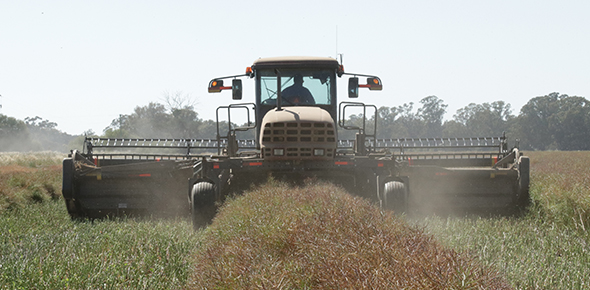Wet year provides stern challenge for fungicides
About
-
Date
11 July, 2018
-
Location
NSW, Tocumwal
About
Date
11 July, 2018
Location
NSW, Tocumwal

Windrowed canola at harvest on Allan Clarke’s property ‘Delby Park’ near Tocumwal NSW.
Mr Clarke’s 320-hectare property ‘Delby Park’, at Tocumwal in NSW, consists of sand through to heavy clays, with the variability allowing for a broad cropping rotation.
“Our main summer crop is lucerne hay and we grow rice when water’s available, while our winter crops are oaten hay for export, wheat and canola,” he explains.
The lucerne hay is particularly valuable as it can be cut early to free up ground for double-cropping into soybeans or rice when water is available for the coming summer.
While he considers water availability to be his biggest challenge, along with building up soil organic matter, Mr Clarke says disease management is also critical.
He believes tighter rotations, with an increasing amount of canola, have growers on high alert for crop diseases.
“Sclerotinia seems to be creeping in a little bit more — we noticed a few years back in a paddock that had soybeans in it previously, and we had it quite bad in the same paddock again since then.”
The very wet 2016 winter cropping season was a perfect example of a season in which Mr Clarke turned to Prosaro® 420 SC Foliar Fungicide from Bayer to protect his canola from disease.
“It was a bulky crop that started flowering really early and with the wet season we were really worried about disease taking off, so we applied Prosaro early, at around 20 per cent flower.
“We then did a second application at 50 per cent flower just because it was so early and it was going to be flowering for a long time in wet conditions and that seemed to have controlled it quite well,” he explains.
Mr Clarke also applied Prosaro to a smaller paddock next to the sclerotinia-infected crop, but with a slightly different approach.
“As that crop was quite thin it wasn’t worth doing the whole area, so we just applied a protective boundary of Prosaro, which seemed to work quite well,” he explains.
Even before harvest, Mr Clarke says it was obvious the product had made a significant impact.
“The main crop had a lot of sclerotinia pressure in it, which had the potential to do a lot of damage but it didn’t seem to have done too much at all.
“That year saw lot of petal drop and crops staying wet for long time, so probably ideal conditions for fungal disease, but Prosaro did a pretty good job of holding the disease up,” he says.
Mr Clarke is planning to continue using Prosaro, which contains the active ingredients prothioconazole and tebuconazole, so he can keep canola in his rotation.
“It’s too valuable of a crop to pull out and you don’t have to lose a lot of crop to cover the cost of Prosaro - even though it’s not a cheap product, I think it’s been effective,” he says.



